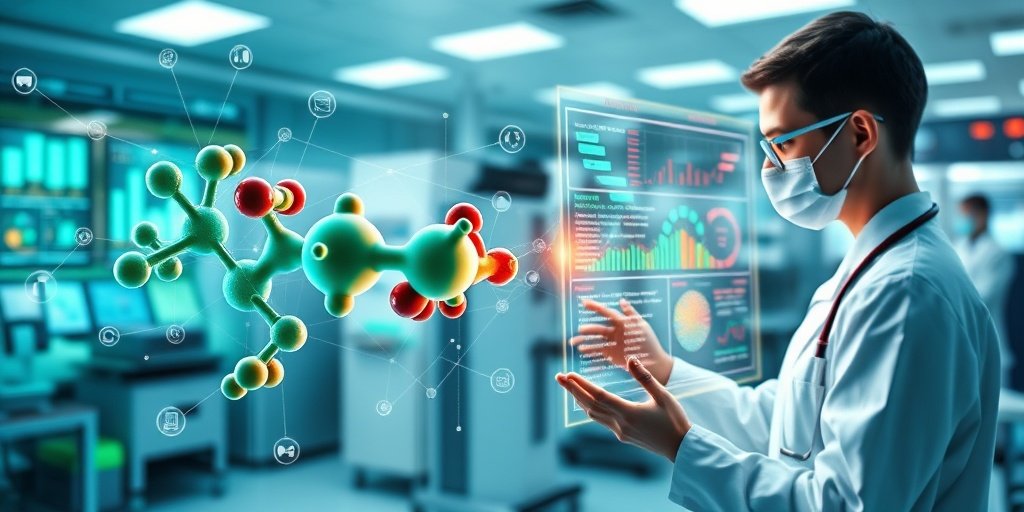⚡ Quick Summary
This comprehensive review explores the integration of artificial intelligence (AI) with reverse docking methodologies in drug discovery, highlighting its potential in drug repurposing and precision medicine. The study emphasizes the transformative impact of AI technologies in optimizing target selection and enhancing drug efficacy predictions.
🔍 Key Details
- 📊 Focus: AI-driven reverse docking in drug discovery
- 🧩 Technologies: Machine learning, deep learning, reinforcement learning
- ⚙️ Applications: Drug repurposing, safety profiling, predicting off-target effects
- 🏆 Case Studies: Successful examples demonstrating the effectiveness of the approach
🔑 Key Takeaways
- 🤖 AI integration is reshaping the landscape of drug discovery.
- 🔍 Reverse docking identifies potential binding sites across diverse protein targets.
- 💡 Machine learning and deep learning enhance target selection and interaction predictions.
- 📈 Challenges include data limitations and algorithmic complexities.
- 🌐 Multi-omics data incorporation is a promising future direction.
- 🏥 Real-time discovery pipelines could personalize medicine further.
- 📚 Comprehensive methodologies ensure robust and reproducible results.
- 🌍 The study highlights the transformative potential of AI in precision medicine.

📚 Background
The field of drug discovery has long faced challenges in identifying effective drug targets and understanding therapeutic interactions. Traditional methods can be time-consuming and often lack precision. The advent of artificial intelligence offers a new paradigm, particularly through the use of reverse docking, which allows researchers to pinpoint potential binding sites across various protein targets, thereby enhancing the drug discovery process.
🗒️ Study
This review synthesizes findings from various studies that have employed AI-driven reverse docking methodologies. By leveraging machine learning and deep learning models, researchers have optimized target selection and interaction predictions. Reinforcement learning techniques have also been utilized to enhance sampling methods, leading to more effective virtual screening workflows.
📈 Results
The integration of AI technologies into reverse docking has demonstrated significant promise, particularly in the realms of drug repurposing and precision medicine. Successful case studies illustrate the effectiveness of these methodologies, showcasing improved predictions of drug efficacy and adverse outcomes. The review emphasizes the importance of high-throughput pipelines capable of processing multi-omics datasets to support comprehensive drug discovery initiatives.
🌍 Impact and Implications
The findings of this review suggest that AI-driven reverse docking could revolutionize drug discovery by streamlining the identification of drug targets and therapeutic interactions. This approach not only enhances the efficiency of drug repurposing but also holds the potential to significantly improve patient outcomes through personalized medicine. The incorporation of real-time discovery pipelines and multi-omics data could further enhance the precision of therapeutic interventions.
🔮 Conclusion
The integration of AI with reverse docking methodologies represents a significant breakthrough in drug discovery. By optimizing target selection and enhancing predictions of drug interactions, this approach paves the way for more effective and personalized therapeutic strategies. As research continues to evolve, the future of drug discovery looks promising, with AI playing a pivotal role in shaping the next generation of medical advancements.
💬 Your comments
What are your thoughts on the integration of AI in drug discovery? We would love to hear your insights! 💬 Leave your comments below or connect with us on social media:
Harnessing AI-driven reverse docking in drug discovery: a comprehensive review of opportunities, challenges, and emerging trends.
Abstract
CONTEXT: The integration of artificial intelligence (AI) with reverse docking methodologies is reshaping drug discovery by streamlining the identification of drug targets and therapeutic interactions. This approach is pivotal in drug repurposing, safety profiling, and predicting off-target effects. Reverse docking uniquely identifies potential binding sites across diverse protein targets, providing insights into drug efficacy and adverse outcomes. AI technologies, such as machine learning, deep learning, and reinforcement learning, enhance this workflow by optimizing target selection, virtual screening, and conformational sampling. Despite challenges like data limitations and algorithmic complexities, AI-driven reverse docking has shown promise in drug repurposing and precision medicine, as illustrated by successful case studies. This review highlights its transformative potential and future prospects, including the incorporation of multi-omics data and real-time discovery pipelines for personalized medicine.
METHODS: The computational strategies discussed leverage reverse docking platforms integrated with AI frameworks. Machine learning and deep learning models were employed for target selection and interaction prediction, while reinforcement learning facilitated advanced sampling techniques. Virtual screening workflows incorporated AI-driven optimizations for docking simulations. These methodologies were implemented using widely recognized computational tools, including AI libraries and molecular docking software, ensuring robust and reproducible results. Challenges in data integration were addressed by employing high-throughput pipelines capable of processing multi-omics datasets, thus supporting comprehensive drug discovery initiatives.
Author: [‘Durojaye OA’, ‘Bellah SF’, ‘Uzoeto HO’, ‘Okoro NO’, ‘Cosmas S’, ‘Ajima JN’, ‘Arazu AV’, ‘Ezechukwu SP’, ‘Ezechukwu CS’, ‘Odiba AS’]
Journal: J Mol Model
Citation: Durojaye OA, et al. Harnessing AI-driven reverse docking in drug discovery: a comprehensive review of opportunities, challenges, and emerging trends. Harnessing AI-driven reverse docking in drug discovery: a comprehensive review of opportunities, challenges, and emerging trends. 2025; 31:256. doi: 10.1007/s00894-025-06480-y